1242 total view(s), 354 download(s)
Claisse_OneFactorANOVA_LessonPlan.pdf(PDF | 78 KB)
Claisse_OneFactorANOVA_swirl.swc(SWC | 12 KB)
- License terms
Description
In this lesson, students will practice interpreting the results of a one-factor analysis of variance (ANOVA). The students will work through two examples. In working through these examples, students do very basic R coding to interpret the structure of the data frames, specify linear models and produce/interpret ANOVA results tables, and do simple calculations to determine effect sizes (pairwise differences between group means). However, much of the code is given to them directly to re-type or modify, but not much prior coding experience is expected. Associated plots are interpreted. Results outputs and plots from post-hoc multiple comparison tests are produced for them, and they practice interpreting them. Students can also watch a short video on the Multiple Testing Problem. They also practice identifying the appropriate Null and Alternative hypotheses associated with one-factor ANOVA.
Cite this work
Researchers should cite this work as follows:
- Claisse, J. (2020). Interpreting one-factor ANOVA in R with swirl. Teaching with R in Undergraduate Biology, QUBES Educational Resources. doi:10.25334/SA4D-PF95
